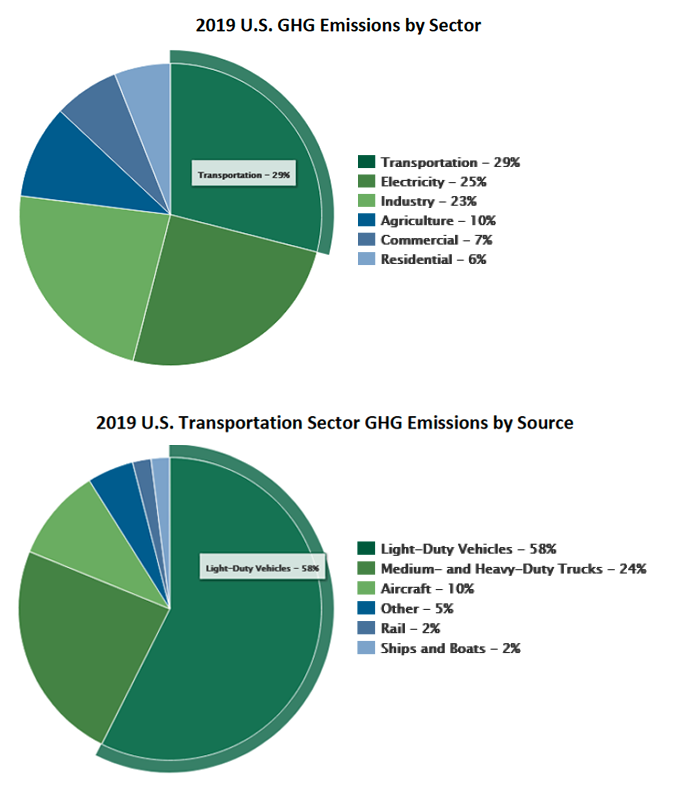There are over one million light duty vehicles (car, pickups, and delivery vans) registered in Palm Beach County. Each year the heat and pressure of internal combustion engine (ICE) piston chambers render 5.25 million tons of breathable oxygen useless to sustain life as it combines with the hydrogen and carbon atoms of 1.65 million tons of gasoline. Each year from the Palm Beach County ICE light duty vehicle tail pipes spew newly formed molecules of over 1.9 million tons of water (steam) and over 5 million tons of carbon dioxide gas. Carbon dioxide (CO2) is a stable molecule which once formed will linger in the atmosphere between 300 to 1,000 years. Therefore nearly all of the carbon dioxide produced from fossil fuels burned over the last century is still in our atmosphere. The carbon dioxide made on I-95 today will add to the amount CO2 in the air until at least the year 2322 and possibly the year 3022.
Carbon dioxide and atmospheric water are both major greenhouse gases. The EPA estimates 17% of the USA greenhouse gas pollution comes from light duty vehicles. Due to the lack of heavy industry, Palm Beach pollution percentages are different from the national average. Of the amount of pollution Palm Beach County generates it is likely 20% or higher of the total amount comes from ICE cars.
Global warming is and will have a greater impact on Palm Beach County than nearly any other area of the country because we are a low elevation, sub-tropical county with its most expensive infrastructure built near the Atlantic Ocean. The Atlantic Ocean has risen 12 inches in the last century and it will rise another 12 inches in less than 30 years. For the best outcome for the citizens of Palm Beach County, the political leadership must be proactive in this silent, invisible, touchless, odorless, tasteless, slow acting but implacable crisis.

On August 5th, 2021 President Biden signed the “Executive Order on Strengthening American Leadership in Clean Cars and Trucks” which states in part: “…Section1. Policy. America must lead the world on clean and efficient cars and trucks. That means bolstering our domestic market by setting a goal that 50 percent of all new passenger cars and light trucks sold in 2030 be zero-emission vehicles, including battery electric, plug-in hybrid electric, or fuel cell electric vehicles.” Actively assisting this goal lies within the mandate of the Palm Beach County Transportation Planning Agency. MPO enabling legislation states in part “In developing the long-range transportation plan and the transportation improvement program required under paragraph (a), each M.P.O. shall provide for consideration of projects and strategies that will: …. Increase the safety and security of the transportation system for motorized and nonmotorized users;…. Protect and enhance the environment, promote energy conservation, and improve quality of life;…. Promote efficient system management and operation;…”
More specifically at the March, 2022 PBC TPA Citizen Advisory Committee meeting TPA staff presented, “a MOTION TO RECOMMEND ADOPTION of 2022 Legislative and Policy Positions” which included the policies 1.d “Mandate adaptive cruise control, lane assistance, and collision avoidance systems on new vehicles.” and policy 4. “Provide funding to advance autonomous, connected, and electric vehicles and infrastructure.”
Achieving the “goal that 50 percent of all new passenger cars and light trucks sold in 2030 be zero-emission vehicles, including battery electric, plug-in hybrid electric, or fuel cell electric vehicles” is possible. Norway accomplished this between the years 2011 and 2018. Now in early 2022, 96% of all new cars sold in Norway are plug-in vehicles.
The estimated number of new cars in 2030 equaling 50% of those sold in PBC is over 52,000. If in 2030 new car sales are 50% plug-ins, this will cumulatively total only 13% of the cars on the road. Therefore 87% of light duty vehicles on the road will still be gasoline and diesel powered. Based on the Norway curve, in 2034 it is likely 100% of new light duty vehicles sold will be plug-ins. In 2034 still 62% of the cars on the road will be the older ICE propelled. Except for registered antiques, all cars on the road in 2042 will likely be plug-ins. When this happens here greenhouse gas pollution from
Palm Beach County will have decreased by at least 1/5th. Government planning at any level which stops the release of carbon dioxide will lower the heat peak and may shorten the negative effects on the planet by decades. Secondly, the infrastructure for ICE cars is a major pillar of the USA economy. The changeover from ICE to BEV will be highly disruptive but government intervention may help ease the transition for many to the new economy.
The actions requested of the PBCTPA Governing Board are:
- Task the Technical Advisory Committee to perform an in depth review of the coming disruptive switch from ICE to BEV light duty vehicles and make recommendations as needed.
- Form a sub committee headed by Governing Board members and composed of representatives from Agency staff, the Technical Advisory Committee and the Citizen Advisory Committee to consider the future direction of the Transportation Planning Agency with regards to Global Warming.
- Make an inter-Agency request to the Florida Department of Highway Safety and Motor Vehicles that an accessible report be maintained categorizing PBC vehicle registrations by make, model and propulsion type.
- The Governing Board wearing their other hats as City Commissioners, Mayors and County Commissioners should reactivate the initiative to establish an accurate accounting of the amount of greenhouse gas pollution generated by Palm Beach County.